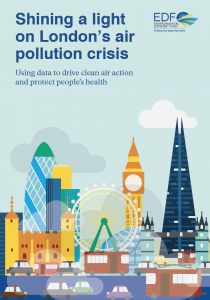London, UK
Turning London pollution data into action

Monitoring air quality is a critical step toward reducing pollution, but data on its own doesn’t necessarily lead to healthier communities.
Using measured and modelled datasets from the ambitious Breathe London pilot project, as well as other London data, we have produced analyses that spotlight the capital’s pollution problem. We’ve examined when and where pollution is worst – as well as who is most impacted – and highlighted specific policies that can address pollution sources.
By making data actionable, we aim to inspire targeted policy action so all Londoners can breathe easier.
Explore our London pollution data stories below, or see here for a full list of analyses.
Breathe London Data to Action summary report 2021
Environmental Defense Fund (EDF)’s Global Clean Air initiative uses air-quality data to build the case for policies that reduce pollution and improve health. In London, we worked with local partners to turn monitored and modelled pollution data into action. Download and read our summary report, “Shining a Light on London’s Air Pollution Crisis.” (PDF).
-
Read the story
The simple switch pubs and restaurants can make that will have a big impact on air pollution
Research by Future Climate for Environmental Defense Fund Europe found that the local nitrogen oxides (NOx) pollution produced by a single standard outdoor gas heater at 5 hours per day for a year is approximately the same as that produced by a typical gas-heated home for a year.
As pubs, cafes and restaurants look for heating options, it is important to choose electric heaters over gas to avoid exposing their staff and the public to air pollutants that are dangerous to health.

-
 Read the story
Read the storyYoung activists warn ‘breathing kills’ as London air pollution hits deprived areas and communities of colour
The burden of London’s air pollution is not equal. A group of Black and brown teens called ‘Choked Up’ installed ‘hacked’ road signs across London, highlighting air pollution and its disproportionate impact on people of colour and deprived communities.
The campaign was underpinned by an analysis that found NO2 pollution is on average 24-31% higher in areas where people from Black, Asian or minority ethnic backgrounds are most likely to live, compared to areas where white people are most likely to live. Additionally, the most deprived Londoners are over six times more likely to live in areas with higher pollution than the least deprived.
-
Read the story
Traffic congestion increasing in London, above 2019 levels outside city centre
Analysis by EDF Europe, based on data from the Waze for Cities Programme, shows that traffic congestion was increasing in London in September 2020 and was worse than 2019 levels outside the city centre.
Traffic congestion disrupts essential journeys and creates unpleasant places to walk and cycle, making it difficult to discourage car use. Urgent action is needed to reduce polluting vehicles and congestion on roads outside the city centre, such as improving cycling infrastructure, consolidating increasing van deliveries and better public transport connectivity.
